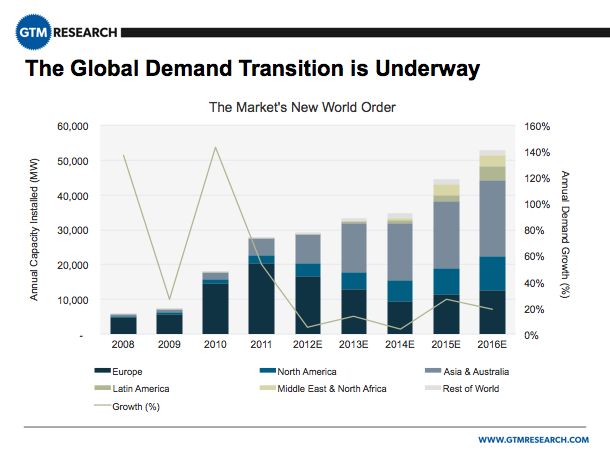The coming 10-gigawatt solar market in China may not offer the business boom the industry hopes, according to a panel of experts at Greentech Media’s Solar Summit.
“There are market forces [to contend with] and good companies do survive, but peeling back the layers, it is also the companies with very good relationships to the government that survive,” explained Azure International Managing Director Chris Raczkowski.
“We see China as a centralized state, and it is true that the decisions are made centrally, but execution of the polices is at the local level,” added Sky Solar COO Petra Leue. It is difficult to do business as an outsider unfamiliar with the provinces “in the same way it would be difficult for a developer from Arizona to do business in New York state or Hawaii.”
“It is difficult, but it is also possible,” said Clean Energy Associates Founder/CEO Andy Klump, "as long as you partner with the right state-owned entity [SOE] or local company. But expect a much lower margin. And the payment terms are horrific. There are competitors out there willing to not take any payment for two years, and sometimes it is four years before they get 100 percent of the payment. You really have to know who your partner is. It takes years and a long-term focus.”
With the oversupply of modules, the panelists agreed, central government subsidies, channeled through the China Development Bank, have been pushed to developers.
But for foreign companies, project development is very difficult, Raczkowski said. “There is opportunity for technology companies, and occasionally service companies, that can come in with something that can squeeze a bit more margin. But you have to have a strategic partner in China and roll it out through that partnership.” It is a fairly easy concept, he said, but going through the process is difficult for a lot of Western companies.
"That is the story we hear over and over," said GTM Research Analyst Scott Burger. "It is possible. It is difficult. You have to have the right partner. And it is difficult to figure out who that right partner is and structure the deal right way. But what good is any of that if the businesses are not making money or, in some cases, have negative margins?"
"Don’t look at it from the individual companies’ point of view, but from the Chinese government’s point of view," said Leue. Their people are employed, “and they are moving toward their announced 8 percent to 11 percent renewables goal with solar parks that are actually producing, unlike the wind parks that are not connected to the grid." She continued, “And when the solar industry eventually reaches global grid parity and it is cheaper to have rooftop solar to generate electricity than to buy it from utilities, China’s industry will see a serious upswing.”
For now, Leue said, the Chinese thinking is to borrow time, to survive the next twenty-four months to 36 months, until there is the opportunity to produce.
“There is a question floating around of whether the Chinese government is really committed to solar,” Raczkowski added. “But their investment didn’t start because of environmental concerns.” It comes down to energy security and employment, he explained. China saw and learned from Germany, where greentech employment overtook auto sector employment. “Solar is not a complete solution today, but the leadership is quite intelligent about technology and science and engineering. They have a clear a strategy baked into five-year plans. China is going to stay committed to this.”

The entire panel discussion is shown below and is also available here.



